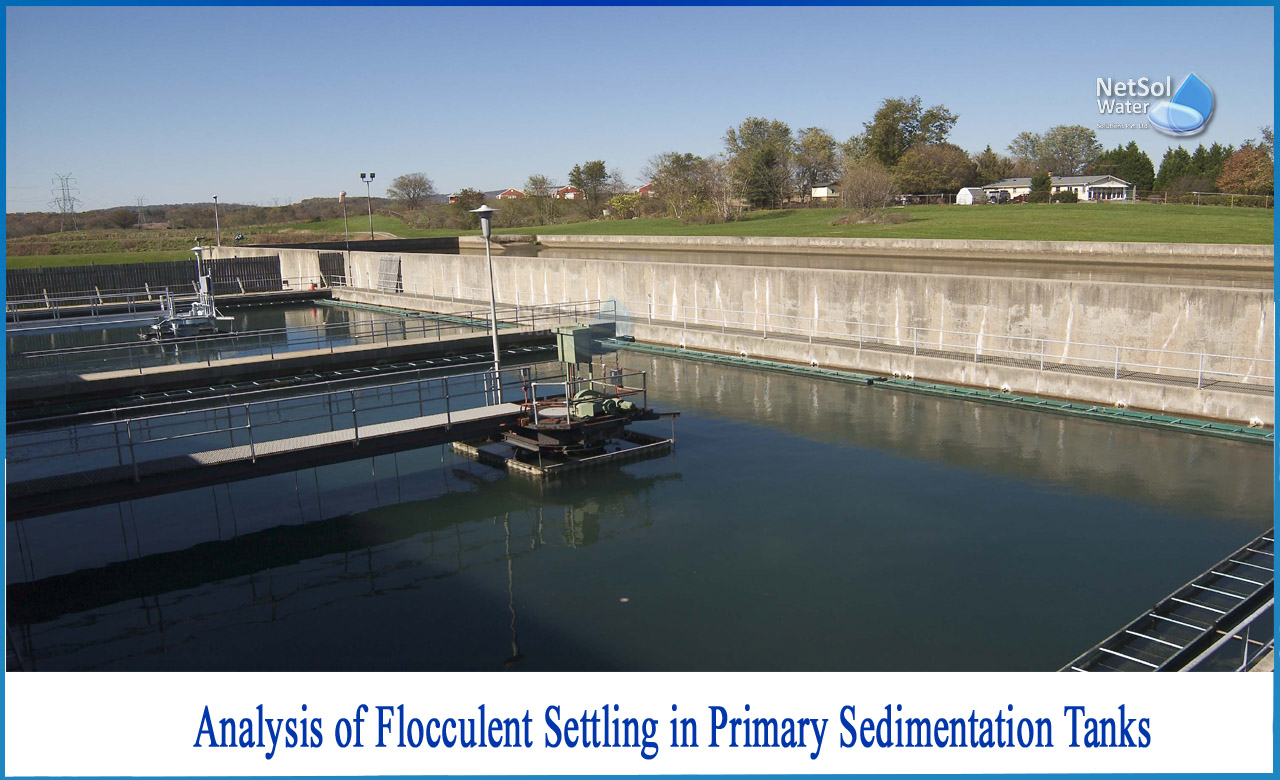Design of primary sedimentation tanks
After the removal of grit, the wastewater containsorganic matter which gets settled in the primary sedimentation tank (PST). Because of the involvement of many unknown factors under settling of non-regular shaped particles, the settling is known as flocculent settling.
The primary sedimentation tank removes suspended solids in the range of 50-70% from the raw sewage.
Various design considerations in PST
1: Velocity: The velocity of 1 cm/sec with detention period of 90 to 150 minutes is used for design purposes.
2: Weir loading: Weir loading less than 185 m3/m.d is used for designing. Effluent weir length is provided at the effluent end of the rectangular tanks, and around the periphery in the circular tanks.
3: Sludge hopper: In circular tanks, the sludge collection hopper is near the centre and in rectangular tanks, it is near the influent end.
4: Baffle: A baffle is provided ahead of the effluent weir for removal of floating matter. The scum formed is removed from the tank periodically either mechanically or manually.
What is Flocculent settling in Primary sedimentation tanks?
Flocculation occurs within a primary sedimentation tank (PST) due to eddying motion of the water or wastewater and aggregation of flocculent solids takes place as the sewage gets detained for longer duration in these tanks. Since the particles are subjected to flocculation, these sedimentation tanks are designed taking into consideration hydraulic resistance time (detention period). The rate of flocculation rapidly decreases when detention period increases beyond certain values.
Following four types of settling may occur depending upon the concentration of solids and the tendency of particles to interact:
Type 1 – Discrete settling- Particles settle individually without any interaction with surrounding particles.
Type 2 – Flocculent settling- It occursdue to flocculation particles increase in mass. The settlement takes place at a faster rate.
Type 3 – Hindered or zone settling- The mass of particles gets settled as a unit and individual particles remain at fixed positions with respect to each other.
Type 4 – Compression settling- The concentration of particles is very high that the sedimentation occurs only through compaction of the structure.
Analysis of Flocculent Settling
Smaller sized particles in relatively dilute concentrations will not act as discrete particles but these particles will coalesce during sedimentation. As flocculation occurs, the particle size increases and its settlement occurs faster.
The intensity of flocculation will depend upon the contact established between the particles, which depends upon overflow rate, temporal mean velocity gradient in the system and concentration and size of the particles.
The basin depth will decide detention time of wastewater in the tank. A column with 15 cm diameter and 3.0 m height gives satisfactory results.The height of the tank should be equal to water depth of the settling tank for obtaining correct results.
Settling should take place under quiescent conditions!
To avoid convection currents, it is important to maintain uniform temperature throughout the experimental column. At various time intervals, samples are taken from the ports and examined for suspended solids. Percentage removal of solids is calculated and it is then plotted as a number (%) against time and depth.
The efficiency of the sedimentation tanksget affected by-
· Eddy currents formed by the incoming fluid inertia,
· Wind turbulence created at the water surface of the uncovered tanks,
· Thermal convection currents,
·Formation of density currents caused by cold or warm water that moves along the bottom of the basin, and
· Thermal stratification in hot climates.
Because of the above reasons,the removal efficiency of the tank and detention time has a correlation,
R = t/(a+b.t),
Where ‘a’ and ‘b’ are empirical constants, ‘R’ is expected removal efficiency and ‘t’ is detention time.
Taking into consideration thenon-optimum conditions, the settling velocity obtained are often multiplied by a factor (0.65 to 0.85), and the detention time is also multiplied by a factor (1.25 to 1.50).
This gives adequate treatment efficiency in the field conditions as obtained under laboratory tests.
Conclusion
Netsol Water is one of the leading water and wastewater treatment company in India with services in the field of WTP manufacturing, WWTP manufacturing, STP manufacturing, ETP manufacturing, among other services. The company designs and manufactures machines and is dedicated to practical solutions that spur business growth and simultaneously preserves world’s most precious resource- WATER!
Netsol Water is Greater Noida-based leading water & wastewater treatment plant manufacturer. We are industry's most demanding company based on client review and work quality. We are known as best commercial RO plant manufacturers, industrial RO plant manufacturer, sewage treatment plant manufacturer, Water Softener Plant Manufacturers and effluent treatment plant manufacturers. Apart from this 24x7 customer support is our USP. Call on +91-9650608473, or write us at enquiry@netsolwater.com for any support, inquiry or product-purchase related query.



